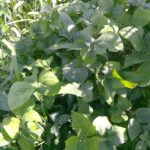By Gabe Ross, Farm Manager

At the end of June, I planted a summer cover crop in the northeast field at Gallant Farm. It consisted of cowpeas, oats and sunflowers. The idea of using cover crops goes back a long way and was often called green manuring. The crops used for this purpose then like clover, vetch, rye and buckwheat are still used today along with many others. Many farmers used to plant clover between their corn rows after the last weed cultivation. This added nitrogen to the soil and prevented erosion. The following year this would become a hay field, or be grazed, or plowed and planted to another crop.
Today farmers are finding places in their crop rotations to fill in with all sorts of interesting and diverse cover crops. We know that, like a healthy prairie ecosystem, the greater diversity of cover crops the greater the benefit. Instead of just a single species cover like rye or clover, mixes are now available with many cover crop species together. Though we are gaining a better understanding of this it isn’t completely new. Dairy farmers in the past planted mixtures of peas and oats for forage and grain. The fact that legumes fix nitrogen from the air with bacteria on their roots has long been known and therefore oats planted along with peas grow better.

The particular mix I planted ended up doing so-so. The cowpeas and sunflowers grew very well, but the oats didn’t come up as hoped. Unfortunately, a lot of foxtail did come up. One of the major reasons for this cover crop was weed suppression, so I ended up letting it grow until just before the foxtail made seed heads then I mowed it down. Ideally, if the foxtail hadn’t been so prevalent, I could have let the cowpeas and sunflowers grow until flowering, fixing more nitrogen and helping pollinators. In addition if the sunflowers had been left to flower and go to seed, it could have been used for chicken feed. This mix could have been used for green feed as well to help the cool season grasses through the summer heat. The cowpea roots did show some nodules indicating some nitrogen fixation and the sunflowers made a lot of biomass. If I use this mix again, I will substitute pearl millet for the oats as the millet is much more heat and drought tolerant. While it didn’t work as planned, I do think the field will be cleaner of weeds for next years corn and the residue will protect the soil from winter erosion.

Stop out at the farm later in the fall to see how our most diverse cover crop yet is doing. This one is in the garden and consists of oats, cowpeas, oilseed radish, kale, winter peas, millet and flax.







